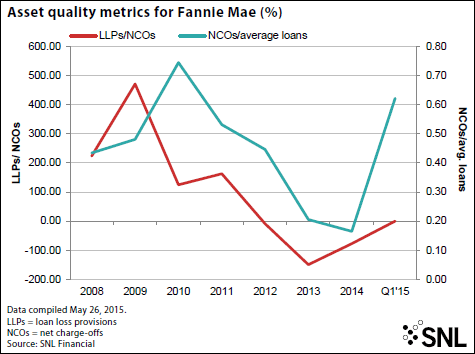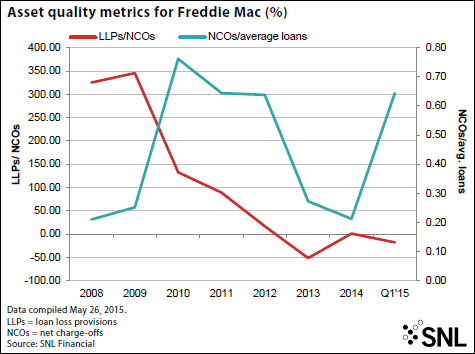A reckoning could be on its way for Fannie Mae and Freddie Mac.
The government-sponsored enterprises are slowly winding down their portfolios and paying the Treasury quarterly dividends; meanwhile, their capital reserves are set to reduce every year until reaching zero by 2018. Their earnings are declining after a surprisingly profitable 2013, and some believe the institutions are now exposed to another downturn in the housing market.
Compass Point analyst Isaac Boltansky called the dwindling capital reserve a sunset provision: "Reduce their capital each year so that, hopefully, at some point in the future, another Congress will handle these issues because they'll have to. It's like a ticking time bomb."
Fannie Mae's net income fell 83% in 2014 to $14.21 billion, while Freddie Mac's fell 84% to $7.69 billion. In the first quarter of 2015, Fannie reported only $1.89 billion in net income while Freddie posted $524 million. Observers and  regulators have warned that if the downward trend continues, the GSEs might need to draw on Treasury funds once again.
regulators have warned that if the downward trend continues, the GSEs might need to draw on Treasury funds once again.
Back to the bailout
In September 2008, the GSEs were  placed into conservatorship of the newly established Federal Housing Finance Agency. They began receiving capital infusions to stay afloat in the form of preferred stock purchases, which totaled $187.4 billion after their last draw in 2012. In return, they agreed to pay the Treasury regular dividends.
placed into conservatorship of the newly established Federal Housing Finance Agency. They began receiving capital infusions to stay afloat in the form of preferred stock purchases, which totaled $187.4 billion after their last draw in 2012. In return, they agreed to pay the Treasury regular dividends.
As of March 31, 2015, according to SNL data, the GSEs have paid in dividends $228.2 billion, $40.8 billion greater than the Treasury investment. That difference has led some to say that the enterprises' "debt" to taxpayers has been paid — but the agreement required the GSEs to pay dividends as a return on investment and states that dividend payments do not reduce prior Treasury draws.
"The payments as dividends don't ever go toward paying down a loan because there's no loan to pay down," Jim Parrott, a senior fellow with the Housing Finance Policy Center at the Urban Institute, told SNL. Barring a change to their current orders, the GSEs will continue paying the dividend indefinitely.
The dividend was originally set to 10% of the investment, but as the enterprises continued reporting net losses, they began drawing on their open credit line with the Treasury to pay the dividend — "moving money from the right hand to the left hand," according to Parrott.
In August 2012, the dividend was  amended into a profit sweep equal to the GSEs' net worth above a set capital reserve. A series of large nonrecurring sources of income in 2013, related to deferred tax assets and legal settlements, sent Fannie's and Freddie's net income — and the dividend — soaring.
amended into a profit sweep equal to the GSEs' net worth above a set capital reserve. A series of large nonrecurring sources of income in 2013, related to deferred tax assets and legal settlements, sent Fannie's and Freddie's net income — and the dividend — soaring.
Diminishing capital reserves
Every year, the GSEs must reduce their mortgage loan portfolios, as well as the size of their capital reserves. According to the 2012 sweep amendment, the GSEs' investment portfolios have been and continue to be wound down at a 15% annual rate. Interest from these portfolios has historically been a major source of income, but revenue also comes from fees charged to guarantee mortgages, which were raised consistently until FHFA director Mel Watt  suspended further increases in January 2014. Fannie Mae spokesman Andrew Wilson referred SNL to President and CEO Timothy Mayopoulos' remarks during Fannie Mae's first-quarter 2015 earnings call. (Freddie Mac and the FHFA did not respond to requests for comment.) Mayopoulos noted that a majority of the enterprise's revenue came from guaranty fees, "a trend that we would expect to continue over time."
suspended further increases in January 2014. Fannie Mae spokesman Andrew Wilson referred SNL to President and CEO Timothy Mayopoulos' remarks during Fannie Mae's first-quarter 2015 earnings call. (Freddie Mac and the FHFA did not respond to requests for comment.) Mayopoulos noted that a majority of the enterprise's revenue came from guaranty fees, "a trend that we would expect to continue over time."
The wind-down will continue until the GSE portfolios hit $250 billion each; as of March 31, Fannie Mae's total mortgage-related portfolio was $411.7 billion, and Freddie Mac owned $405.6 billion in mortgage assets, according to their quarterly filings. Meanwhile, the GSEs' capital reserve allocation is set to shrink $600 million per year until it hits zero on Jan. 1, 2018.
| 
|
Some industry observers argue that preventing the GSEs from building up a capital reserve leaves them vulnerable to external forces, like a housing market downturn, and internal forces, such as accounting losses. Without net income, if Fannie or Freddie reports a large enough accounting loss, it would be forced to take a draw on the preferred share purchase line to pay the net worth-based dividend. If a GSE's net worth itself goes into the red, it would have to draw on the Treasury to cover the negative net worth amount, according to a March 18 FHFA report. With a sufficient capital buffer, they could offset losses on the books or negative net worth and avoid a draw. In the same earnings call, Mayopoulos said that Fannie Mae expects to remain profitable on an annual basis but that external factors, including interest rates and home prices, "could result in significant variability in our financial results from quarter to quarter, and year to year."
| 
|
Accounting losses have already proven to be a problem for Freddie, which hedges against the volatility inherent in the wind-down of its portfolio using derivatives. In 2014, it reported a total of $8.29 billion in derivative losses — more than three times its derivatives loss in 2012. "If they have to declare a loss that's big enough to actually take them into the red, they're going to have to have a draw, even if the economics of it aren't actually negative," Parrott said.
Will Congress act?
Congress may need a shock to get moving. "I think there's at least a decent chance we'll be pushed back to the table in a moment of some panic" spurred by a GSE draw, Parrott said. Boltansky echoed that sentiment: "At least on financial issues, we tend to legislate only in times of crisis."
Earlier  bipartisan
bipartisan  forays into GSE reform never reached the president's desk. Now, the regulatory reform
forays into GSE reform never reached the president's desk. Now, the regulatory reform  bill recently introduced by Sen. Richard Shelby, R-Ala., may be the last chance for congressional action until after the approaching election year, and its window is steadily closing. For Parrott, an optimistic scenario involves specific pieces of legislation passing in the current Congress that make significant reform easier in the future. Of all the bill's sections, Title VII, which details changes to the GSEs, has "the most viability built into it." Rather than laying out an overhaul of the housing finance system, the bill envisions a means of gathering information that would ultimately make that kind of lasting reform easier to achieve.
bill recently introduced by Sen. Richard Shelby, R-Ala., may be the last chance for congressional action until after the approaching election year, and its window is steadily closing. For Parrott, an optimistic scenario involves specific pieces of legislation passing in the current Congress that make significant reform easier in the future. Of all the bill's sections, Title VII, which details changes to the GSEs, has "the most viability built into it." Rather than laying out an overhaul of the housing finance system, the bill envisions a means of gathering information that would ultimately make that kind of lasting reform easier to achieve.
The bill alters the course of Common Securitization Solutions LLC, the joint venture between Fannie and Freddie that establishes a new platform for issuing mortgage-backed securities. The CCS currently has no timeline for the build-out and only a vague instruction to "allow for the integration of additional market participants in a future system," according to the FHFA's 2015 GSE scorecard. Shelby's bill states explicitly that other entities be allowed to issue securities through the platform and adds deadlines to its development.
One year after the bill's enactment, the FHFA would report to Congress a timeline for "completing development of the Platform to support the securitization needs of issuers other than the enterprises." Three years after enactment, the agency must create a plan "to transition the Platform from a joint venture owned by the enterprises into a private, nonprofit entity that best facilitates a…secondary mortgage market for mortgage-backed securities." Meanwhile, CSS must develop standards for the approval of non-GSE entities to issue on the platform and rules for what loans can serve as collateral for issued securities.
The bill also includes what Boltansky called "crisp and clear congressional support" for the expansion of upfront risk sharing, in which private mortgage insurers would take some credit risk "before it touches the GSE balance sheets."
Boltansky also noted that the bill would ease  restrictions on membership in the Federal Home Loan Banks System. Mortgage REITs that have
restrictions on membership in the Federal Home Loan Banks System. Mortgage REITs that have  created captive insurers to access FHLB funds would have an easier time joining and staying in that system.
created captive insurers to access FHLB funds would have an easier time joining and staying in that system.
Shelby's bill makes no changes to the dividend or capital reserve, the specters that continue to hover over the GSEs. But Parrott argues that the bill could still be an essential step. "If you fast forward a few years, and Congress is scrambling back to the table to do GSE reform…one, they'll have a big platform they can allow others to dock into, and two, they'll have a lot more info on what structures for first-loss risk sharing actually work."
The big questions remain whether either or both of the GSEs take a loss in the meantime, and in what kind of political environment a draw on the Treasury might occur. A bailout could occur during the turmoil of the 2016 elections; or, if Fannie or Freddie takes a loss and draws on taxpayer dollars while Republicans control Congress or the White House, the GSEs could become an ideological target and be eliminated altogether. "We [could] wake up one day with a very difference housing finance system," Parrott said.

